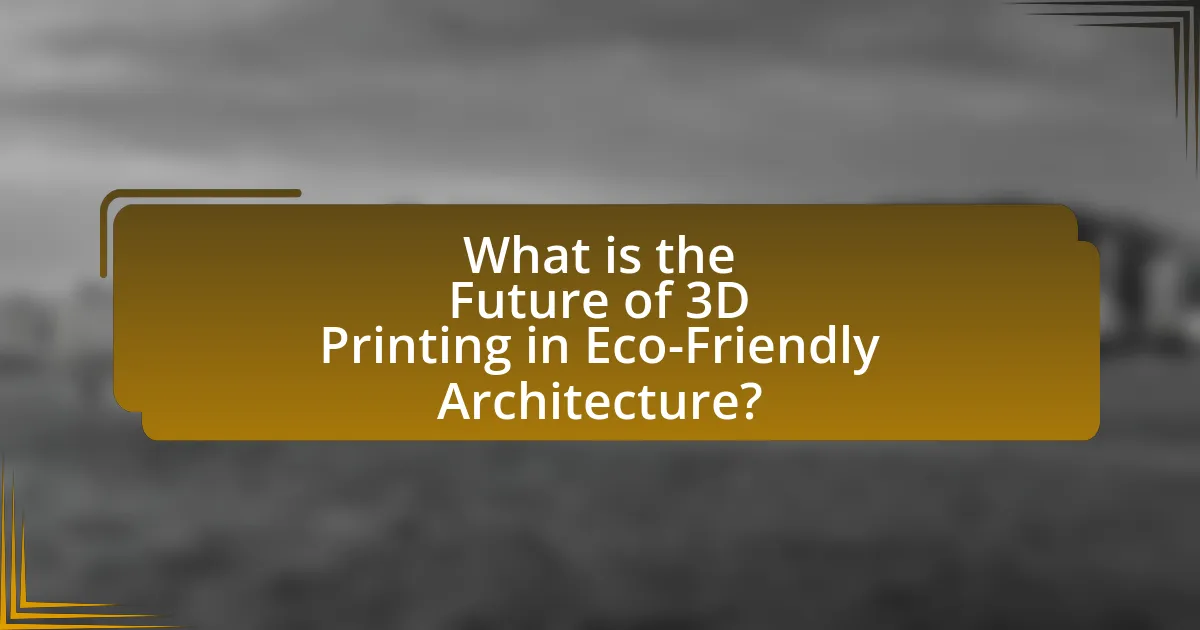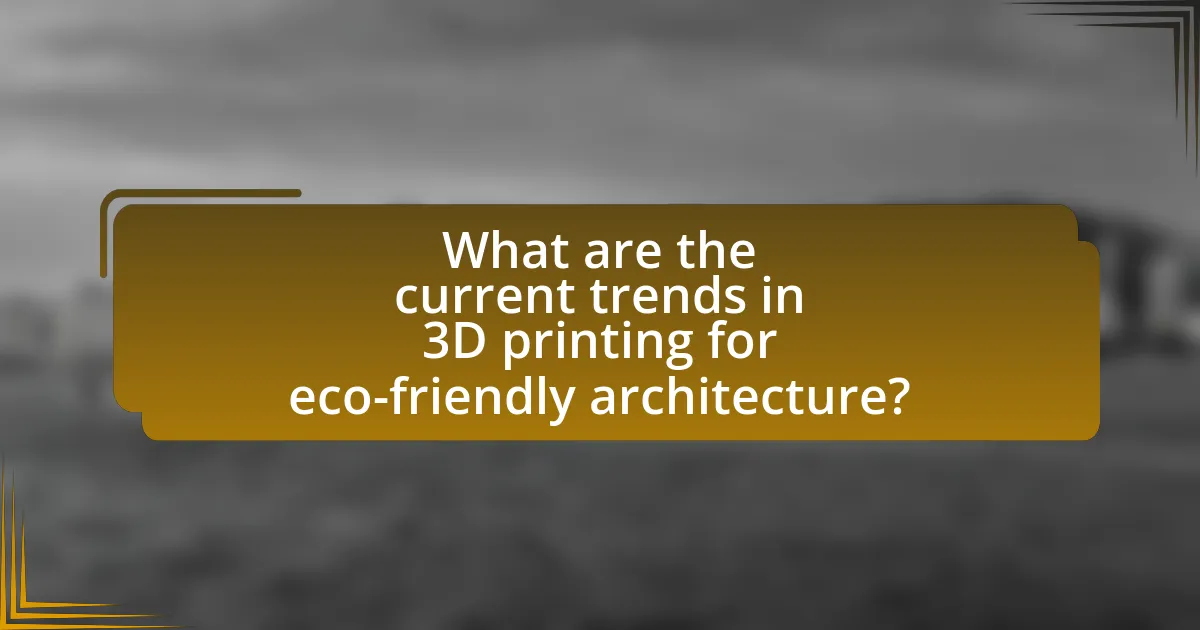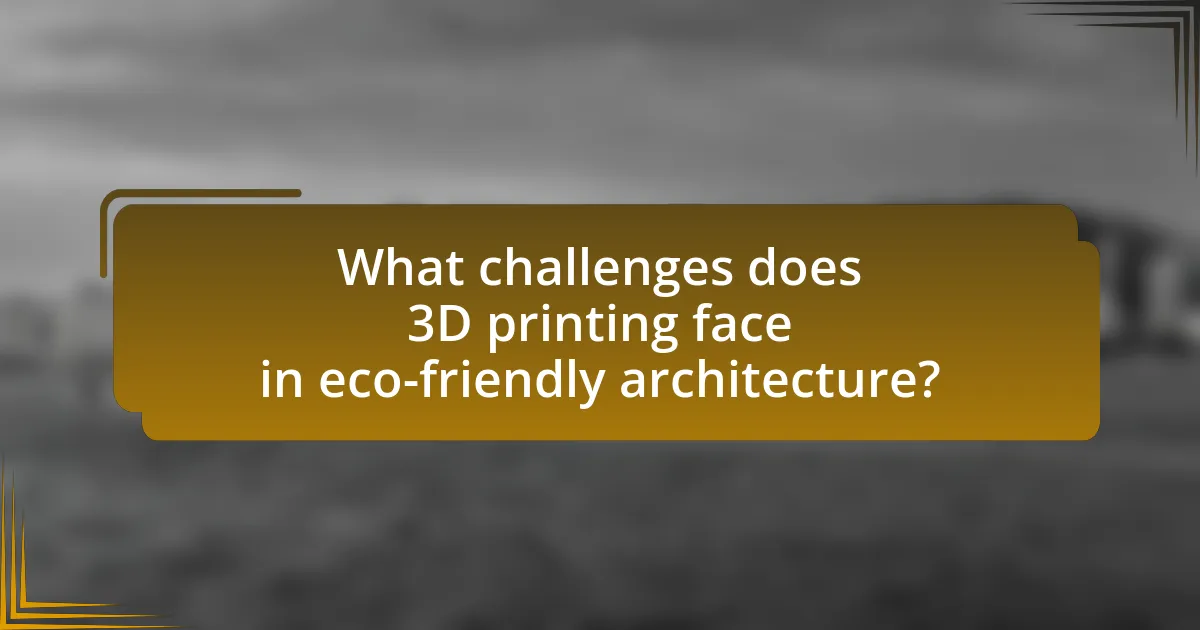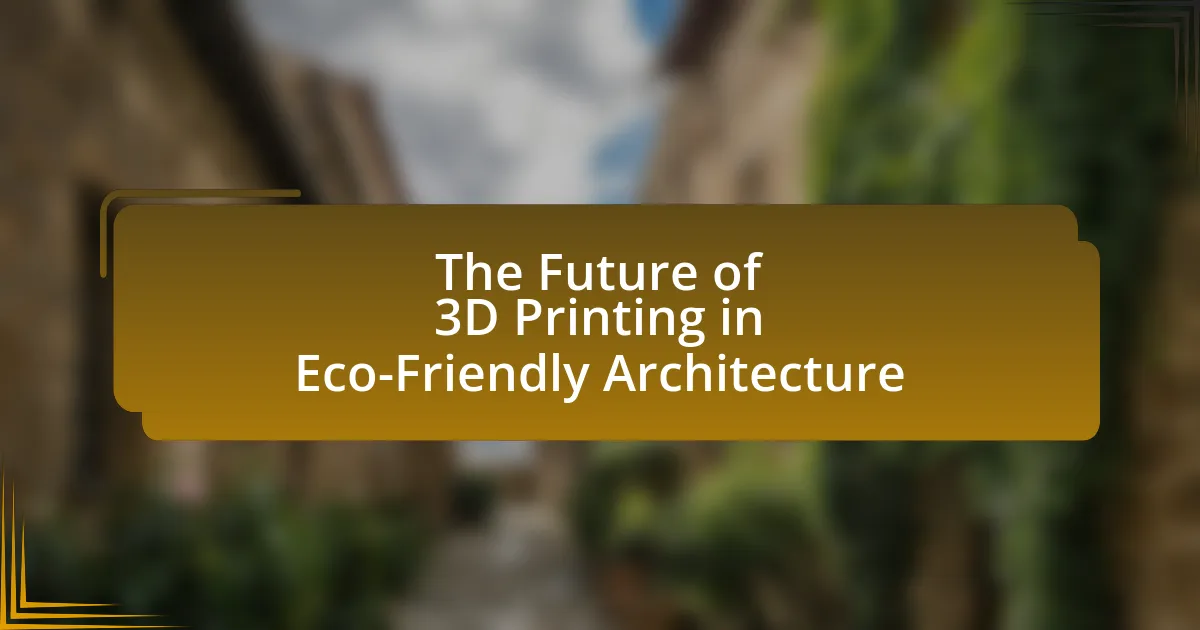The article focuses on the future of 3D printing in eco-friendly architecture, highlighting its potential for growth through advancements in sustainable materials and construction techniques. It discusses how 3D printing reduces waste and carbon footprints by utilizing recycled materials and bio-based composites, while also enhancing energy efficiency in buildings. Key technologies such as additive manufacturing and robotic fabrication are examined, along with the environmental impacts of traditional construction methods. The article also addresses the challenges faced by 3D printing in architecture, including regulatory hurdles and safety concerns, while emphasizing the importance of collaboration and education in overcoming these barriers to promote sustainable building practices.

What is the Future of 3D Printing in Eco-Friendly Architecture?
The future of 3D printing in eco-friendly architecture is poised for significant growth, driven by advancements in sustainable materials and construction techniques. As the technology evolves, it enables the use of recycled materials and bio-based composites, reducing waste and carbon footprints. For instance, companies like ICON are already utilizing concrete mixtures that incorporate recycled materials, demonstrating a practical application of eco-friendly 3D printing. Furthermore, the ability to create complex structures with minimal material waste enhances energy efficiency in buildings, aligning with global sustainability goals. This trend is supported by research indicating that 3D printing can reduce construction time by up to 70%, further promoting eco-friendly practices in the architecture industry.
How is 3D printing transforming the field of architecture?
3D printing is transforming the field of architecture by enabling rapid prototyping, customization, and sustainable construction methods. This technology allows architects to create complex designs that were previously difficult or impossible to achieve with traditional construction techniques. For instance, 3D printing can reduce material waste by using only the necessary amount of resources, which aligns with eco-friendly practices. Additionally, structures can be printed on-site, minimizing transportation emissions and costs. A study by the University of Southern California found that 3D-printed buildings can be constructed in a fraction of the time compared to conventional methods, further enhancing efficiency in architectural projects.
What are the key technologies driving 3D printing in architecture?
The key technologies driving 3D printing in architecture include additive manufacturing, concrete 3D printing, and robotic fabrication. Additive manufacturing allows for the layer-by-layer construction of structures, enabling complex designs that traditional methods cannot achieve. Concrete 3D printing specifically utilizes specialized concrete mixtures that cure quickly, allowing for rapid construction and reduced waste. Robotic fabrication enhances precision and efficiency in the printing process, enabling architects to create intricate designs with high accuracy. These technologies collectively contribute to sustainable building practices by minimizing material waste and energy consumption, aligning with eco-friendly architecture goals.
How does 3D printing contribute to sustainable building practices?
3D printing contributes to sustainable building practices by significantly reducing material waste and enabling the use of eco-friendly materials. Traditional construction methods often result in up to 30% material waste, whereas 3D printing allows for precise material usage, minimizing excess. Additionally, 3D printing can utilize recycled materials and bio-based composites, further decreasing the environmental impact. For instance, a study by the University of Southern California found that 3D printing can reduce the carbon footprint of construction by up to 50% when using sustainable materials. This innovative approach not only enhances efficiency but also promotes a circular economy in the building sector.
Why is eco-friendly architecture important for the future?
Eco-friendly architecture is important for the future because it significantly reduces environmental impact and promotes sustainability. This architectural approach minimizes resource consumption, lowers greenhouse gas emissions, and enhances energy efficiency. For instance, buildings designed with eco-friendly principles can reduce energy use by up to 50% compared to traditional structures, as reported by the U.S. Green Building Council. Additionally, eco-friendly architecture often incorporates renewable materials and technologies, which contribute to a circular economy and reduce waste. This shift is crucial as urbanization continues to rise, with the UN projecting that 68% of the world’s population will live in urban areas by 2050, necessitating sustainable building practices to ensure a livable future.
What are the environmental impacts of traditional construction methods?
Traditional construction methods significantly contribute to environmental degradation through resource depletion, waste generation, and greenhouse gas emissions. The extraction of raw materials, such as timber, concrete, and metals, leads to habitat destruction and biodiversity loss. Additionally, traditional construction generates substantial waste; for instance, the construction and demolition sector accounts for approximately 30% of total waste in many countries. Furthermore, the energy-intensive processes involved in manufacturing building materials and the operation of heavy machinery result in high levels of carbon emissions, contributing to climate change. According to the Intergovernmental Panel on Climate Change, the building sector is responsible for nearly 40% of global energy-related CO2 emissions. These impacts highlight the urgent need for more sustainable construction practices, such as those offered by 3D printing technologies.
How can eco-friendly architecture mitigate climate change?
Eco-friendly architecture can mitigate climate change by reducing greenhouse gas emissions through sustainable design practices and materials. This approach often incorporates energy-efficient systems, renewable energy sources, and sustainable materials, which collectively lower the carbon footprint of buildings. For instance, buildings designed with passive solar heating can significantly decrease reliance on fossil fuels for heating, while the use of recycled materials minimizes waste and resource extraction. According to the U.S. Green Building Council, green buildings can reduce energy use by 30% to 50% compared to conventional buildings, demonstrating a clear link between eco-friendly architecture and climate change mitigation.
What role does 3D printing play in reducing waste in construction?
3D printing significantly reduces waste in construction by enabling precise material usage and minimizing excess. Traditional construction methods often result in substantial waste due to over-ordering and cutting materials to fit, whereas 3D printing allows for on-demand production, which aligns material use closely with design specifications. According to a study by the University of Southern California, 3D printing can reduce material waste by up to 60% compared to conventional methods. This efficiency not only conserves resources but also lowers costs associated with waste disposal and material procurement.
How does additive manufacturing minimize material waste?
Additive manufacturing minimizes material waste by using a layer-by-layer approach that only deposits material where it is needed, significantly reducing excess material compared to traditional subtractive manufacturing methods. This technique allows for precise control over the amount of material used, resulting in up to 90% less waste in some applications. For instance, a study by the Massachusetts Institute of Technology found that additive manufacturing can reduce material waste by as much as 50% in certain construction processes, demonstrating its efficiency and sustainability in eco-friendly architecture.
What are the benefits of using recycled materials in 3D printing?
Using recycled materials in 3D printing significantly reduces environmental impact by minimizing waste and conserving resources. This practice lowers the demand for virgin materials, which in turn decreases energy consumption and greenhouse gas emissions associated with material extraction and processing. For instance, a study published in the journal “Resources, Conservation and Recycling” found that using recycled plastics in 3D printing can reduce energy use by up to 60% compared to using new plastics. Additionally, incorporating recycled materials can lead to cost savings in production, as recycled feedstocks are often less expensive than their virgin counterparts.

What are the current trends in 3D printing for eco-friendly architecture?
Current trends in 3D printing for eco-friendly architecture include the use of sustainable materials, such as recycled plastics and bio-based composites, which reduce environmental impact. Additionally, advancements in technology enable the construction of energy-efficient structures through optimized designs that minimize waste and enhance thermal performance. For instance, projects like ICON’s 3D-printed homes utilize concrete mixtures that incorporate recycled materials, demonstrating a commitment to sustainability. Furthermore, the integration of renewable energy systems, such as solar panels, into 3D-printed designs is becoming increasingly common, promoting energy self-sufficiency in buildings. These trends reflect a growing emphasis on reducing carbon footprints and promoting sustainable living in architectural practices.
How are architects integrating 3D printing into their designs?
Architects are integrating 3D printing into their designs by utilizing additive manufacturing techniques to create complex structures and components that are both efficient and sustainable. This technology allows for the production of intricate geometries that traditional construction methods cannot achieve, thereby reducing material waste and enabling the use of eco-friendly materials. For instance, projects like the 3D-printed Habitat for Humanity house demonstrate how 3D printing can lower construction costs and time while promoting sustainable practices. Additionally, research from the University of Southern California highlights that 3D printing can significantly decrease the carbon footprint of building processes by minimizing excess material usage and energy consumption.
What innovative projects showcase 3D printing in eco-friendly architecture?
Innovative projects showcasing 3D printing in eco-friendly architecture include the “TECLA” house in Italy, which is constructed using natural materials like clay and is designed to be fully sustainable. This project exemplifies how 3D printing can reduce waste and energy consumption in building processes. Another notable example is the “ICON” project in Austin, Texas, which aims to provide affordable housing through 3D-printed homes made from a proprietary concrete mix that minimizes environmental impact. These projects demonstrate the potential of 3D printing technology to create sustainable living spaces while addressing housing shortages and environmental concerns.
How are design processes evolving with 3D printing technology?
Design processes are evolving with 3D printing technology by enabling rapid prototyping, customization, and sustainable material use. This technology allows architects and designers to create complex structures and components that were previously difficult or impossible to achieve with traditional methods. For instance, 3D printing can reduce material waste by using only the necessary amount of material for each design, aligning with eco-friendly practices. Additionally, the ability to quickly iterate designs through digital modeling and printing accelerates the development process, allowing for more innovative and efficient architectural solutions.
What materials are being used in 3D printing for sustainable architecture?
Biodegradable plastics, recycled materials, and bio-based composites are being used in 3D printing for sustainable architecture. Biodegradable plastics, such as polylactic acid (PLA), are derived from renewable resources like corn starch and are designed to decompose naturally, reducing environmental impact. Recycled materials, including repurposed plastics and metals, minimize waste by transforming discarded items into usable printing filaments. Bio-based composites, which combine natural fibers with polymers, offer strength and sustainability, making them suitable for construction applications. These materials collectively contribute to reducing carbon footprints and promoting eco-friendly building practices.
What are the advantages of bioplastics in 3D printing?
Bioplastics offer several advantages in 3D printing, primarily their sustainability and reduced environmental impact. These materials are derived from renewable resources, such as corn starch or sugarcane, which decreases reliance on fossil fuels. Additionally, bioplastics are often biodegradable, meaning they can break down naturally over time, reducing plastic waste in landfills. Research indicates that using bioplastics can lower carbon emissions during production compared to traditional plastics, further contributing to eco-friendly practices in architecture. For instance, a study published in the journal “Materials” highlights that bioplastics can significantly reduce the carbon footprint associated with 3D printing processes.
How do alternative materials enhance sustainability in construction?
Alternative materials enhance sustainability in construction by reducing environmental impact through lower carbon emissions and resource consumption. For instance, materials like bamboo, recycled plastics, and rammed earth have been shown to require significantly less energy to produce compared to traditional materials such as concrete and steel. According to a study published in the Journal of Cleaner Production, using bamboo can reduce carbon emissions by up to 90% compared to conventional building materials. Additionally, alternative materials often utilize waste products, further minimizing landfill contributions and promoting a circular economy. This shift not only conserves natural resources but also fosters innovation in construction practices, aligning with sustainable development goals.

What challenges does 3D printing face in eco-friendly architecture?
3D printing in eco-friendly architecture faces challenges such as material sustainability, energy consumption, and regulatory hurdles. The use of eco-friendly materials is limited, as many 3D printing materials are derived from non-renewable resources, which contradicts the principles of sustainability. Additionally, the energy required for 3D printing processes can be significant, raising concerns about the overall carbon footprint of the construction. Regulatory frameworks often lag behind technological advancements, creating barriers for the adoption of 3D printing in building codes and standards. These challenges hinder the full integration of 3D printing into eco-friendly architectural practices.
What are the regulatory hurdles for 3D printed buildings?
The regulatory hurdles for 3D printed buildings include a lack of established building codes, zoning laws that do not accommodate new construction methods, and the need for compliance with safety and structural integrity standards. Many jurisdictions have not yet developed specific regulations for 3D printing technology, which can lead to delays in project approvals and increased costs. For instance, the International Code Council is working on developing guidelines, but as of now, many areas still rely on traditional construction codes that do not account for the unique aspects of 3D printing. Additionally, local governments may impose restrictions based on aesthetic concerns or neighborhood compatibility, further complicating the approval process for innovative building techniques.
How do building codes affect the adoption of 3D printing?
Building codes significantly influence the adoption of 3D printing in construction by establishing safety, structural integrity, and material standards that must be met. These regulations can either facilitate or hinder the integration of 3D printing technologies, as they often require compliance with traditional building methods and materials, which may not align with the innovative approaches of 3D printing. For instance, the International Code Council has begun to develop guidelines specifically for 3D-printed structures, indicating a shift towards accommodating this technology. However, the lack of universally accepted codes can create uncertainty for builders, potentially slowing down the adoption of 3D printing in eco-friendly architecture.
What safety concerns are associated with 3D printed structures?
Safety concerns associated with 3D printed structures include structural integrity, material toxicity, and fire hazards. Structural integrity can be compromised due to layer adhesion issues, leading to potential failures under load, as evidenced by studies showing that certain 3D printed materials may not meet traditional building codes. Material toxicity arises from the use of certain plastics and resins that can emit harmful fumes during printing, which poses health risks to workers and occupants. Additionally, fire hazards are a concern, as some 3D printed materials may have lower fire resistance compared to conventional building materials, increasing the risk of fire spread. These factors highlight the need for rigorous testing and adherence to safety standards in the use of 3D printing for construction.
How can the industry overcome barriers to widespread adoption?
The industry can overcome barriers to widespread adoption of 3D printing in eco-friendly architecture by enhancing collaboration among stakeholders, improving technology accessibility, and increasing public awareness. Collaborative efforts between architects, engineers, and material scientists can lead to innovative solutions that address technical challenges and regulatory hurdles. For instance, partnerships with universities and research institutions can facilitate the development of sustainable materials specifically designed for 3D printing. Additionally, making technology more accessible through training programs and affordable equipment can empower smaller firms to adopt these practices. Public awareness campaigns highlighting the environmental benefits and cost-effectiveness of 3D printing in construction can further drive acceptance and demand, as evidenced by a report from the World Economic Forum indicating that sustainable building practices can reduce carbon emissions by up to 40%.
What role do education and training play in advancing 3D printing?
Education and training are crucial in advancing 3D printing by equipping individuals with the necessary skills and knowledge to innovate and implement this technology effectively. Specialized programs in engineering, design, and materials science focus on the principles of additive manufacturing, enabling students to understand the complexities of 3D printing processes. For instance, universities and technical institutes are increasingly offering courses that cover software proficiency, machine operation, and material selection, which are essential for creating sustainable and efficient 3D-printed structures in eco-friendly architecture. Furthermore, industry partnerships with educational institutions facilitate hands-on training and research opportunities, fostering a skilled workforce capable of pushing the boundaries of 3D printing applications in sustainable building practices.
How can collaboration between stakeholders enhance innovation?
Collaboration between stakeholders enhances innovation by combining diverse expertise and resources, leading to more creative solutions. In the context of eco-friendly architecture and 3D printing, stakeholders such as architects, engineers, material scientists, and environmentalists can share insights that drive sustainable design practices. For instance, a study by the National Institute of Standards and Technology found that collaborative projects in construction led to a 20% increase in efficiency and a significant reduction in waste. This synergy not only accelerates the development of innovative materials and techniques but also fosters a culture of shared responsibility towards sustainability, ultimately resulting in more effective and environmentally friendly architectural solutions.
What are the best practices for implementing 3D printing in eco-friendly architecture?
The best practices for implementing 3D printing in eco-friendly architecture include using sustainable materials, optimizing design for material efficiency, and integrating renewable energy sources. Sustainable materials, such as recycled plastics or bio-based composites, reduce environmental impact and promote circular economy principles. Optimizing design involves minimizing waste through efficient geometries and structures, which can be achieved using advanced software tools that simulate material usage. Additionally, integrating renewable energy sources, like solar panels, into 3D printed structures enhances energy efficiency and reduces reliance on fossil fuels. These practices collectively contribute to a more sustainable architectural approach, aligning with global efforts to reduce carbon footprints and promote environmental stewardship.
How can architects effectively choose materials for 3D printing?
Architects can effectively choose materials for 3D printing by evaluating the mechanical properties, sustainability, and compatibility of materials with the printing technology. Mechanical properties such as strength, flexibility, and thermal resistance are crucial for ensuring the structural integrity of printed components. Sustainable materials, like bioplastics or recycled composites, align with eco-friendly architecture goals, reducing environmental impact. Compatibility with specific 3D printing technologies, such as Fused Deposition Modeling (FDM) or Stereolithography (SLA), is essential for achieving desired print quality and performance. Research indicates that using materials like bio-based polymers can significantly lower carbon footprints, supporting the transition to sustainable building practices.
What strategies can be employed to ensure sustainability in projects?
To ensure sustainability in projects, particularly in eco-friendly architecture, strategies such as utilizing renewable materials, implementing energy-efficient designs, and adopting waste reduction practices can be employed. Utilizing renewable materials, like bamboo or recycled plastics, minimizes environmental impact and promotes resource conservation. Energy-efficient designs, which may include passive solar heating and natural ventilation, reduce energy consumption and lower carbon footprints. Additionally, adopting waste reduction practices, such as 3D printing techniques that optimize material use and minimize excess waste, aligns with sustainable project goals. These strategies collectively contribute to the long-term viability and environmental responsibility of architectural projects.
